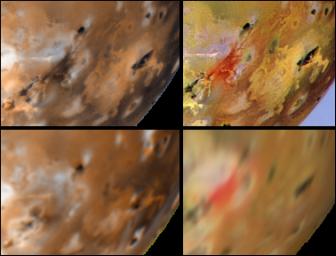Changes around Marduk Between Voyager, and Galileo’s First Two Orbits
Caption:
Detail of changes around Marduk on Jupiter's moon Io as seen by Voyager 1 in 1979 (upper left) and NASA's Galileo spacecraft between June 1996 (lower left) and September 1996 (upper and lower right). The new dark red linear feature extending southeast from Marduk is about 250 kilometers long and may be a volcanic fissure. The flow-like feature at the bottom of the images is distinct in the Voyager data, indistinct in the June Galileo data, but distinct again in the September Galileo data. This may be due to the different lighting conditions rather than volcanic activity. The Voyager 1 image uses the green, blue, and violet filters. The upper right September 1996 image from Galileo uses the violet and green filters of the solid state imaging system aboard the Galileo spacecraft and a synthetic blue to simulate Voyager colors. The lower June and September, 1996 Galileo images use the imaging system's near-infrared (756 nm), green, and violet filters. North is to the top in all frames.
Background Info:
The Jet Propulsion Laboratory, Pasadena, CA manages the Galileo mission for NASA's Office of Space Science, Washington, DC. JPL is an operating division of California Institute of Technology (Caltech).
This image and other images and data received from Galileo are posted on the World Wide Web, on the Galileo mission home page at URL http://galileo.jpl.nasa.gov. Background information and educational context for the images can be found at
http://www.jpl.nasa.gov/galileo/sepo
.
Cataloging Keywords:
| Name |
Value |
Additional Values |
| Target |
Io |
|
| System |
Jupiter |
|
| Target Type |
Satellite |
|
| Mission |
Galileo |
Voyager |
| Instrument Host |
Galileo Orbiter |
|
| Host Type |
Orbiter |
Flyby Spacecraft |
| Instrument |
Solid-State Imaging (SSI) |
|
| Detector |
|
|
| Extra Keywords |
Color, Infrared, Volcano |
| Acquisition Date |
|
| Release Date |
1997-11-18 |
| Date in Caption |
|
|
| Image Credit |
NASA/JPL/University of Arizona |
| Source |
photojournal.jpl.nasa.gov/catalog/PIA01066 |
| Identifier |
PIA01066 |

 Planetary Data System
Planetary Data System
